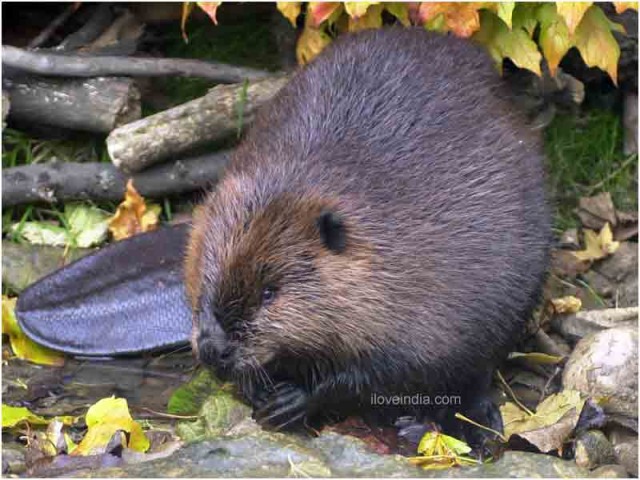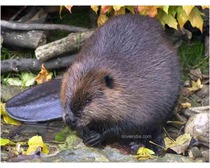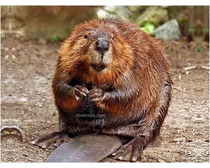There are several facts about beaver which will surprise you, if you are have not explored the animal in detail till now. Read on to know some interesting and amazing information on beavers.
Facts About Beaver
Beavers are large, nocturnal and semi-aquatic rodents, which are known for their unique skill of building dams and lodges. They are closely related to squirrels, as they share some structural similarities with them, with regard to lower jaw and skull. Beavers have long, dense fur and their color varies from reddish brown to black. Both the sexes have scent glands, which are located in a pouch in the anal region. The gland secretes musky oil called castoreum, which is meant to provide sexual attraction. Beavers form monogamous families and live in colonies. They reside in self-constructed homes and work independently. These rodents mainly consume aquatic and shore plants. During winter, they depend on the bark of trees. They are responsible for the creation of several woodland ponds, which support lush vegetation, eventually turning them into meadows. Read on to explore some more interesting facts and amazing information on beavers.

Facts About Beaver
Kingdom: Animalia
Phylum: Chordata
Subphylum: Vertebrata
Class: Mammalia
Order: Rodentia
Family: Castoridae
Genus: Castor
Species: 3 species (C. canadensis, C. fiber, C. californicus)
Height: 2 m
Length: 60 to 100 cm (head to body), 20 to 30.5 cm (tail)
Weight: Approximately 60 lbs (27 kg)
Age: Approximately 16 years
Diet: Herbivorous
Gestation Period: 107 days (approx)
Number of Offspring: 2 to 4 (per litter)
Interesting And Amazing Information About Beavers
- Beavers are the largest rodent of the world, second only to capybara. They continue to grow throughout their life.
- They are known for building canals, lodges and dams. They carry out their construction process of dam on rivers and streams and build their homes near to the pond.
- They have sharp teeth, with which they cut plants and trees for building purpose.
- In case of the absence of a pond, beavers build dams before constructing their home. They place the vertical poles and then fill them with a crisscross of horizontally placed branches. They use weed and mud to fill in the gaps between the branches and continue to do this till the dam retains sufficient water to surround the lodge.
- In some places, beavers are considered as pests or invasive species, as they often modify their natural environment, by constructing dams.
- Beavers have poor eyesight, but are equipped with strong senses of hearing, smell and touch.
- Female beavers are as large as their male counterpart, of the same age. This feature is uncommon amongst mammals.
- Beavers have a powerful “danger signal”, which helps them warn their colonies against an approaching danger.
- A swimming beaver dives immediately when it perceives a danger and forcibly moves the water. This creates a loud “slap”, which sends out a warning note to other beavers that remain submerged in the water till the danger is gone.
- Beavers are slow on land, but make excellent swimmers. They can stay in the water for as long as 15 minutes. They use their tails to paddle against the water, which helps them swim swiftly.
- Beavers do not hibernate.
- All the beavers do not build dams. Some beavers, like the European beavers, rest into the sides of the river banks.
- While diving, the ears and nose of beavers close immediately, preventing the intake of water.
- They also have a third eyelid, which cover the eyeballs when they dive underwater.
- Beavers do not encourage other beaver families to enter into their domain. They secrete a yellowish fluid from their scent glands, present under the tail, to keep off other beaver families.
- They can stand on their hind legs when on land. They can transport mud, logs and rocks to their homes.
- The fur of beavers is naturally waterproof and oily. Their front teeth grow continuously, which helps them gnaw, chew and chop properly.
- Beavers are second only to humans, in their extraordinary ability to influence and change their environment.
- A beaver colony contains only one active adult pair, who will mate for life. Mating takes place in water in early February.


See also
More from iloveindia.com
- Home Remedies | Ayurveda | Vastu | Yoga | Feng Shui | Tattoos | Fitness | Garden | Nutrition | Parenting | Bikes | Cars | Baby Care | Indian Weddings | Festivals | Party ideas | Horoscope 2015 | Pets | Finance | Figures of Speech | Hotels in India : Delhi | Hyderabad | Chennai | Mumbai | Kolkata | Bangalore | Ahmedabad | Jaipur
- Contact Us Careers Disclaimer Privacy Policy Advertise With Us Lifestyle Sitemap Copyright iloveindia.com. All Rights Reserved.




